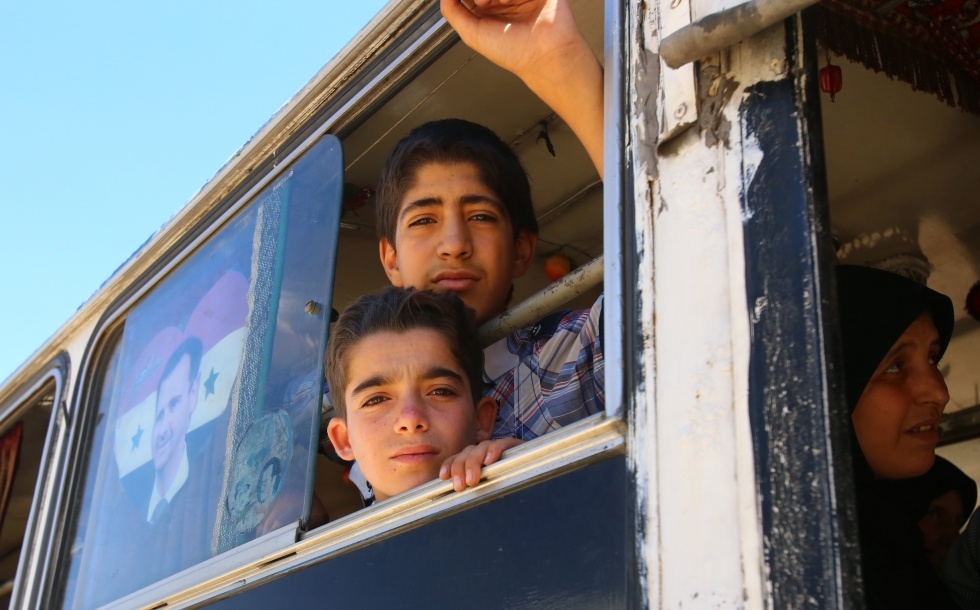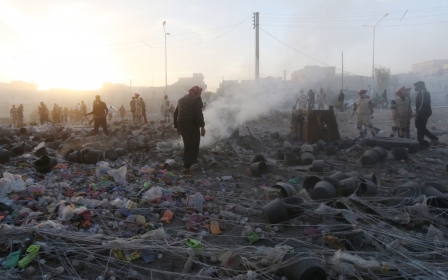Politics and bombardment from above: Re-humanising the Syrian people

Here’s the news: as the US-led coalition bomb ISIS from above, ISIS struggles to spare itself of what seems to be a strategic defeat in Kobane. While the coalition is attacking ISIS, the Assad regime bombs the people who live in neighbourhoods that revolted against him earlier.
But in this war, the humanistic aspect of the civilians living with and against the militancy is misperceived.
For instance, Reuters Graphics manages to keep its infographic on “Fighting the Islamic State” up-to-date; with a geographic map showing the changes in territorial control of each fighting group, weapon comparison of groups, and number of US-led airstrikes.
The spatial size of a colour-identified group on Reuter’s map changes as territories are lost or gained. Yet, the people living there are not represented in Reuters Graphics, as their movement within the territory and without it is irrelevant to the battle itself. In such context, the events become perceived as exclusively military, and consequently the only civilian dimension is in its numerical humanitarian implications: death toll.
But people are trying to survive, and they exist before being killed in groups, threatened to be killed in groups, or forced out in numbers. Syrians are trying to improvise ways to survive and live with the crisis. Civilians who are managing to live with anarchy of militias or brutality of the regime are ignored. They are not appreciated in the changing discourse of media on the Syrian events.
In praising and appreciating such Syrians, one can go as far as seeing their civilian existence as revolutionary. By insisting on living life in its civil nature, civilians in Syria are in a state of rebellion, a behavioural rejection of militarising their lives.
Yet, the politics of numbers and media fascination with the geopolitics of the battle - ISIS expansion and withdrawal - have reduced Syrians to ethnic groups, tribes, and minorities with predetermined collective action - killed or immigrated. Syrians are not seen as agents of any sort in the ongoing conflict. They are, instead, “represented” by a war that is termed as civil.
Civilians are seen as groups, not as persons, who are, according to their imposed ethnic/religious identities, mere subjects to the knives of ISIS or the barrels of Assad. For instance, “anti-terrorism” rhetoric does not acknowledge the civilian dynamics within the geographic space of the battles.
Obama’s red line reaffirms this claim. The US saw a need for action when Assad allegedly used chemical weapons in killing. So, it is not the act of killing civilians that required a metaphorical red line. It is the weaponry used. The military event is what mattered, not the people. There are no people in Obama’s red line. There is a type of weaponry that is unpermitted.
When Syrian events were perceived as an uprising, the rebels were upheld and the FSA (Free Syrian Army) was labelled as the good in Western moral standards. Assad’s regime was given the “evil” label. Syrians were seen as either mass revolutionaries or victims of brutality. When Islamic groups expanded at the expense of a mismanaged and helpless FSA, the rebels became “evil” in the media and the atrocities of the regime were overshadowed with “rational” western-dressed, English-speaking representatives of Assad ranting about the “terrorist rebels.”
Civilians, in this phase of media framing, are still collective victims of the evil. This time, however, they are the victims of the rebels. This time, they are not victims as Syrians. Instead, they are victims as Kurds, Alawites, moderate Sunnis, etc. They remained collectively labelled, but some ethnic/sectarian categories were emphasised over others, according to the politics of the battles. The battle never allows for Syrians to be humans. Such identification inevitably delegitimises the power-certified significance of the blood-shed.
The legitimacy of an exhaustive destructive war also comes from the conventional war drama of media coverage. As the war is given a “civil” label, the fighting groups build on legitimacy under the pretence of mass representation. Reporters go to Syria and film rebel groups go on with their battles, eat, chat, and do “human” activities. We are yet to see a report on living with Syrians, day by day, and covering the “civil” in Syria.
To be fair, there is a humanistic appeal in the media. This appeal, however, similarly reduces the Syrians to a helpless collective: mass refugees or numbers of casualties. In the media today, the humanistic appeal to the Syrian conflict is refugee-related: the subjugation of a population that is completely helpless and mass-led away from its land.
So the dehumanisation of the Syrian people is sustained under a power-related assumption that the war is civil, and thus in some way or another - to a certain degree that depends on the media channel you watch - it represents the people.
Assad regains this town or that, ISIS takes over this town or that. But civilians, residents of these towns, are only “present” in the news when they are subjugated to one of the fighting groups. Syrians as individuals, families, neighbourhoods, or residents are collectively labelled in sectarian/ethnic categories and are only relevant when collectively forced to be part of a military/violent endeavour.
There is something dehumanising about such categorical representations or misrepresentations - or more accurately - underrepresentation. While analysts compete over their ability to communicate the complexities of the war in Syria, the Syrians’ realities - as being not one collective reality - is given shallower thought, less interest and attention. The psychosocial nuance of civilian existence is overshadowed by the euphoria of violence. Having said that, one can only ponder on how much the dehumanisation of Syrians serves the extension of war over the urgency of diplomatic-civil resolution.
Being a Syrian civilian in the midst of a self-destructive war is an act of resistance. Under such statements, we must depict, appreciate, and uphold the “civil” in peace rather than the “civil” in war. The “civil” in peace comes from within the Syrian neighbourhoods. Women, men, and children who improvise tools for survival are resisting, no matter how macro-politically insignificant that is. Those who insist on underestimating such nuances are less interested in people and more interested in power. History shows that power doesn’t bring peace, people do.
Middle East Eye propose une couverture et une analyse indépendantes et incomparables du Moyen-Orient, de l’Afrique du Nord et d’autres régions du monde. Pour en savoir plus sur la reprise de ce contenu et les frais qui s’appliquent, veuillez remplir ce formulaire [en anglais]. Pour en savoir plus sur MEE, cliquez ici [en anglais].





